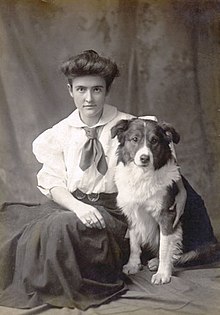Alice Morgan Wright
Alice Morgan Wright (born October 10, 1881 in Albany , New York ; died April 8, 1975 there ) was an American sculptor, suffragette, and animal rights activist .
Life
Wright was the only child of Henry Romeyn Wright, a wholesale merchant, and Emma Jane Morgan. She attended St. Agnes School in Albany and then Smith College , which she graduated in 1904. There she got involved in a society that campaigned for women's suffrage , and there she met her lifelong partner and fellow activist Edith Goode . She then studied sculpture in New York City at the Art Students League of New York and from 1909 at the Académie des Beaux-Arts and the Académie Colarossi in Paris. There she became involved again as a suffragette. Wright advocated women's rights as she felt her own barriers while studying sculpture. Men doubted whether their physical strength would be sufficient to make a sculpture, and she was forbidden to study male models for nudes.
In both Paris and Albany she organized performances by the British suffragette Emmeline Pankhurst in 1910 and 1911, respectively . She was arrested at a suffragette demonstration in London ; During her two months in prison in Holloway Prison , she made a statue of her fellow inmate Emmeline Pankhurst. While in detention, she went on a hunger strike and made sculptures from the unused food of her fellow inmates. After her return to the United States in 1914, she became chairwoman of the Woman Suffrage Party there , which campaigned for equal suffrage for women. In 1915 she took part in an exhibition at the Macbeth Gallery which benefited the suffragette movement. Only after the extension of women's suffrage in the USA in 1920 by the 19th Amendment to the Constitution did she return to sculpture full-time.
Her sculpture was influenced by Cubism and Futurism from 1914 , making her one of the first Americans to create avant-garde sculptures. The Fist is one of her best-known modernist works . Her work has been exhibited in the USA and Europe. She took part in the controversial Armory Show in New York in 1913 and was exhibited at the Royal Academy of Arts in London, the Art Institute of Chicago , the Salon des Beaux Arts in Paris and the Philadelphia Institute of Art , among others .
From 1945 to 1947 she was chairman of the World Women's Party .
Increasingly, Wright turned to animal rights. In 1945 she founded her own animal welfare organization, the National Humane Education Association, and was involved in numerous other organizations on the subject. She and Edith Goode were founding members of the National Humane Society (later the Humane Society of the United States, HSUS) in 1954 and, in the years to come, brought the organization to increasingly campaign for animal rights at the United Nations level . In 1957, Wright wrote a letter to President Eisenhower to persuade him not to use animals for experiments with nuclear weapons. In 1963 she and Goode bought a farm in Virginia and donated it to HSUS to turn it into an animal shelter.
Web links
- Alice Morgan Wright in the database of Find a Grave (English)
Individual evidence
- ↑ a b c d Alice Morgan Wright Papers, 1873-1994. In: Five College Archives & Manuscript Collections. Retrieved March 18, 2018 .
- ^ A b Albany Institute of History and Art (Ed.): Albany Institute of History & Art: 200 Years of Collecting . SUNY Press, 1998, ISBN 978-1-55595-101-6 , pp. 160 .
- ↑ a b c Alice Morgan Wright. In: Smithsonian American Art Museum. Retrieved March 18, 2018 .
- ↑ a b c Bernard Unti: Goode and Wright: Protecting Animals What a Life and Death Decision. In: The Humane Society of the United States. Archived from the original on March 19, 2018 ; accessed on September 2, 2019 .
| personal data | |
|---|---|
| SURNAME | Wright, Alice Morgan |
| BRIEF DESCRIPTION | American sculptor, suffragette, and animal rights activist |
| DATE OF BIRTH | October 10, 1881 |
| PLACE OF BIRTH | Albany , New York |
| DATE OF DEATH | April 8, 1975 |
| Place of death | Albany , New York |
